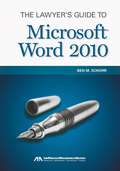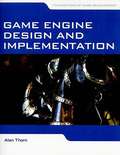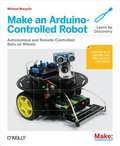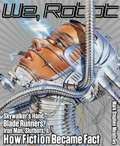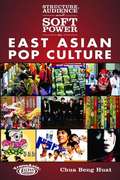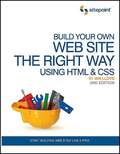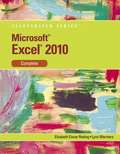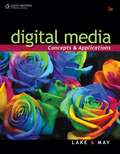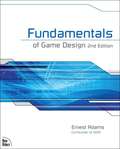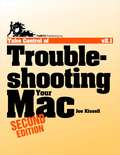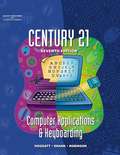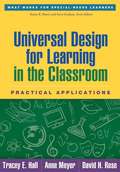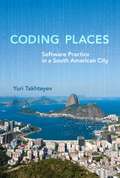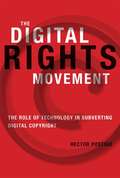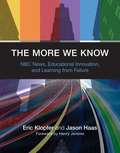- Table View
- List View
Social Media for Lawyers: The Next Frontier
by Nicole Black Carolyn ElefantAttorneys Elefant and Black provide a variety of ways for lawyers to take advantage of social media in their practice. General topics include: an overview of social media in the legal profession, why it is gaining traction with lawyers, types of social media platforms, choosing and implementing social media tools, networking and relationship building, branding and search engine optimization, getting started, best practices, and ethical and legal issues. Annotation ©2010 Book News, Inc. , Portland, OR (booknews. com)
LinkedIn® In One Hour for Lawyers
by Dennis Kennedy Allison C. ShieldsLawyers work in a world of networks, connections, referrals, and recommendations. For many lawyers, the success of these networks determines the success of their practice. LinkedIn®, the premier social networking tool for business, can help you create, nurture, and expand your professional network and gain clients in the process. LinkedIn® in One Hour for Lawyers provides an introduction to this powerful tool in terms that any attorney can understand
The Lawyer's Guide to Microsoft® Word 2010
by Ben M. SchorrThis handy reference includes clear explanations, legal-specific descriptions, and time-saving tips for getting the most out of Microsoft Word®--and customizing it for the needs of today's legal professional. Focusing on the tools and features that are essential for lawyers in their everyday practice, The Lawyer's Guide to Microsoft® Word 2010 explains in detail the key components to help make you more effective, more efficient, and more successful.
The Lawyer's Guide to Microsoft® Outlook 2010
by Ben M. SchorrThe Lawyer's Guide to Microsoft® Outlook 2010 is the only guide written specifically for lawyers to help you be more productive, more efficient and more successful. More than just email, Outlook is also a powerful task, contact, and scheduling manager that will improve your practice.
Internet Branding For Lawyers: Building The Client-centered Website
by Jeff LantzCovering methods applicable to firms serving individuals as well as firms serving businesses, this reader-friendly guide shows how to create a brand and a website for a law firm. Lantz, a consultant in brand creation and website development who holds an MBA in finance, advises readers to focus on the customer perspective: how will you help me and how much will it cost. The book begins by explaining the increased importance of branding in today's information age, then explains how to build a brand around the law firm's practices and how to communicate the brand through website content and design. The final section of the book is given over to technical details and decisions related to areas such as content management systems, choosing a website developer, search optimization, domain names, and servers and website hosting. The book includes many bullets and checklists, along with b&w photos, screenshots, and examples of logos. Annotation ©2012 Book News, Inc. , Portland, OR (booknews. com)
Google for Lawyers: Essential Search Tips and Productivity Tools
by Carole A. Levitt Mark E. RoschLevitt, an attorney and former law librarian and Rosch, an attorney who runs a website for lawyers doing Internet research, detail how lawyers can use free and low-cost tools available through Google to compete with large firms and their large research and technology budgets. They explain how to use Google Scholar's case law database, Gmail, advertising, and the Google applications: Docs, News, Groups, Images, Blogs, Finance, Books, Chrome, Knol, Maps, Desktop Search, Calendar, Voice, Wave, Analytics, Translate, and other programs for basic and advanced research and office use. They include tips for searching case law and articles; locating information about the opposition, expert witnesses and jurors, and clients; and finding missing witnesses and heirs. Screen shots are included. Annotation ©2010 Book News, Inc. , Portland, OR (booknews. com)
Cloud Computing for Lawyers
by Nicole Black Richard SusskindAs more businesses move their IT systems into the cloud, lawyers need to ask if cloud computing is right for their firm. Cloud Computing for Lawyers features a discussion of cloud computing fundamentals, an overview of legal cloud computing products, and step-by-step instructions for implementing cloud computing in your practice--including practical tips for securing your data.
Game Engine Design and Implementation (Foundations of Game Development)
by Alan ThornAlmost every video game on the market today is powered by a game engine. But, what is a game engine? What does it do? How are they useful to both developers and the game? And how are they made? These, and other important engine related questions, are explored and discussed in this book. In clear and concise language, this book examines through examples and exercises both the design and implementation of a video game engine. Specifically, it focuses on the core components of a game engine, audio and sound systems, file and resource management, graphics and optimization techniques, scripting and physics, and much more. Suitable for students, hobbyists, and independent developers, this no-nonsense book helps fine-tune an understanding of solid engine design and implementation for creating games that sell.
Make an Arduino-Controlled Robot
by Michael Margolis<p>Building robots that sense and interact with their environment used to be tricky. Now, Arduino makes it easy. With this book and an Arduino microcontroller and software creation environment, you’ll learn how to build and program a robot that can roam around, sense its environment, and perform a wide variety of tasks.</p>
We, Robot: Skywalker's Hand, Blade Runners, Iron Man, Slutbots, and How Fiction Became Fact
by Mark Stephen MeadowsExamining favorite science fiction tales to reveal which robots actually exist today--and what's coming tomorrow--"We, Robot" asks: How close to becoming reality are our favorite science fiction robots? And what might be the real-life consequences of their existence?
Structure, Audience and Soft Power in East Asian Pop Culture
by Chua Beng HuatEast Asian pop culture can be seen as an integrated cultural economy emerging from the rise of Japanese and Korean pop culture as an influential force in the distribution and reception networks of Chinese language pop culture embedded in the ethnic Chinese diaspora. Taking Singapore as a locus of pan-Asian Chineseness, Chua Beng Huat provides detailed analysis of the fragmented reception process of transcultural audiences and the processes of audiences' formation and exercise of consumer power and engagement with national politics. In an era where exercise of military power is increasingly restrained, pop culture has become an important component of soft power diplomacy and transcultural collaborations in a region that is still haunted by colonization and violence. The author notes that the aspirations behind national governments' efforts to use popular culture is limited by the fragmented nature of audiences who respond differently to the same products; by the danger of backlash from other members of the importing country's population that do not consume the popular culture products in question; and by the efforts of the primary consuming country, the People's Republic of China to shape products through co-production strategies and other indirect modes of intervention.
Build Your Own Web Site the Right Way Using HTML & CSS (2nd Edition)
by Ian LloydBuild Your Own Website The Right Way Using HTML & CSS, 2nd Edition teaches web development from scratch, without assuming any previous knowledge of HTML, CSS or web development techniques. This book introduces you to HTML and CSS as you follow along with the author, step-by-step, to build a fully functional web site from the ground up. However, unlike countless other "learn web design" books, this title concentrates on modern, best-practice techniques from the very beginning, which means you'll get it right the first time. The web sites you'll build will: Look good on a PC, Mac or Linux computer Render correctly whether your visitors are using Internet Explorer, Firefox, Opera, or Safari Use web standards so your sites will be fast loading and easy to maintain Be accessible to disabled users who use screen readers to browse the Web By the end of the book, you'll be equipped with enough knowledge to set out on your first projects as a professional web developer, or you can simply use the knowledge you've gained to create attractive, functional, usable and accessible sites for personal use.
Microsoft® Excel® 2010, Illustrated, Complete
by Elizabeth Eisner Reding Lynn WermersLoved by instructors for its visual and flexible way to build computer skills, the Illustrated Series is ideal for teaching MICROSOFT OFFICE EXCEL 2010 to both computer rookies and hotshots. Each two-page spread focuses on a single skill, making information easy to follow and absorb. Large, full-color illustrations represent how the students' screen should look. Concise text introduces the basic principles of the lesson and integrates a case study for further application.
Business Computer Information Systems II (Texas Edition)
by Pearson EducationBusiness Computer Information Systems II presents advanced concepts and skills of Microsoft Office XP (Microsoft Word, Microsoft Excel, Microsoft Access, and Microsoft Outlook®). Through a learn-by-doing approach, students are challenged to master Microsoft Office within a business context. Additional features throughout the book also provide insight into how software can be used in other academic areas and in the business world.
Digital Media: Concepts and Applications (3rd Edition)
by Susan E. L. Lake Karen MayDIGITAL MEDIA, CONCEPTS AND APPLICATIONS, 3E prepares students for the workplace by teaching them to use business-standard software applications to complete projects and solve problems. The non-software-specific approach gives students a strong foundation in the concepts and practices of digital multimedia and allows the text to focus on the more creative end of business technology.
Fundamentals of Game Design (2nd Edition)
by Ernest AdamsA definitive guide to game theory and design by an industry insider. Comprehensive overview of video game design as it is done in industry. Chapters devoted to each of the major game genres. Exercises of real practical value to help hone your skills. Fundamentals of Game Design, Second Edition teaches the essential theory needed to design entertaining and enjoyable video games. It addresses such key issues as concept development, gameplay design, core mechanics, user interfaces, storytelling, and balancing. The book is aimed at both students in beginning game design courses and anyone that wants to get up-to-speed on the latest game design theory and practice.
Take Control of Troubleshooting Your Mac
by Joe KissellThe 17 basic troubleshooting procedures (along with the reasons why they can help) you'll learn are: Restart your Mac Force-quit an application Start up from another volume Run disk-repair utilities Erase and restore from backup Repair permissions Start up in safe mode Turn off login items Check preference files Reset PMU, SMU, SMC, NVRAM, or PRAM Use Activity Monitor Check free disk space Check log files Clear caches Check your RAM Test for reproducibility Get system information Joe also explains how to solve 15 common problems, including: Your computer won't turn on Your computer keeps turning itself off You experience repeated kernel panics Your Mac is abnormally slow You can't empty the Trash An application grinds to a halt An application crashes The keyboard or mouse doesn't work You lose your Internet connection Printing doesn't work Spotlight searches fail Keychain (seemingly) forgets passwords Apple Mail fails to connect Time Machine misbehaves A volume won't unmount
Century 21 Computer Applications and Keyboarding (7th Edition)
by Jack P. Hoggatt Jon A. Shank Jerry W. RobinsonThis 7th edition is a revision of Century 21 Keyboarding & Information Processing which reflects the changing keyboarding course. The complete course contains 150 keyboarding and word processing lessons, 54 computer apps lessons, and 15 new key learning lessons (in the Resources section).
Universal Design for Learning in the Classroom
by Anne Meyer Tracey HallClearly written and well organized, this book shows how to apply the principles of universal design for learning (UDL) across all subject areas and grade levels. The editors and contributors describe practical ways to develop classroom goals, assessments, materials, and methods that use UDL to meet the needs of all learners. Specific teaching ideas are presented for reading, writing, science, mathematics, history, and the arts, including detailed examples and troubleshooting tips. Particular attention is given to how UDL can inform effective, innovative uses of technology in the inclusive classroom.
Coding Places
by Yuri TakhteyevSoftware development would seem to be a quintessential example of today's Internet-enabled "knowledge work"--a global profession not bound by the constraints of geography. In Coding Places, Yuri Takhteyev looks at the work of software developers who inhabit two contexts: a geographical area--in this case, greater Rio de Janeiro--and a "world of practice," a global system of activities linked by shared meanings and joint practice. The work of the Brazilian developers, Takhteyev discovers, reveals a paradox of the world of software: it is both diffuse and sharply centralized. The world of software revolves around a handful of places--in particular, the San Francisco Bay area--that exercise substantial control over both the material and cultural elements of software production. Takhteyev shows how in this context Brazilian software developers work to find their place in the world of software and to bring its benefits to their city. Takhteyev's study closely examines Lua, an open source programming language developed in Rio but used in such internationally popular products as World of Warcraft and Angry Birds. He shows that Lua had to be separated from its local origins on the periphery in order to achieve success abroad. The developers, Portuguese speakers, used English in much of their work on Lua. By bringing to light the work that peripheral practitioners must do to give software its seeming universality, Takhteyev offers a revealing perspective on the not-so-flat world of globalization.
The Digital Rights Movement
by Hector PostigoThe movement against restrictive digital copyright protection arose largely in response to the excesses of the Digital Millennium Copyright Act (DMCA) of 1998. In The Digital Rights Movement, Hector Postigo shows that what began as an assertion of consumer rights to digital content has become something broader: a movement concerned not just with consumers and gadgets but with cultural ownership. Increasingly stringent laws and technological measures are more than incoveniences; they lock up access to our "cultural commons. " Postigo describes the legislative history of the DMCA and how policy "blind spots" produced a law at odds with existing and emerging consumer practices. Yet the DMCA established a political and legal rationale brought to bear on digital media, the Internet, and other new technologies. Drawing on social movement theory and science and technology studies, Postigo presents case studies of resistance to increased control over digital media, describing a host of tactics that range from hacking to lobbying. Postigo discusses the movement's new, user-centered conception of "fair use" that seeks to legitimize noncommercial personal and creative uses such as copying legitimately purchased content and remixing music and video tracks. He introduces the concept of technological resistance--when hackers and users design and deploy technologies that allows access to digital content despite technological protection mechanisms--as the flip side to the technological enforcement represented by digital copy protection and a crucial tactic for the movement.
The More We Know
by Eric Klopfer Jason HaasIn 2006, young people were flocking to MySpace, discovering the joys of watching videos of cute animals on YouTube, and playing online games. Not many of them were watching network news on television; they got most of their information online. So when NBC and MIT launched iCue, an interactive learning venture that combined social networking, online video, and gaming in one multimedia educational site, it was perfectly in tune with the times. iCue was a surefire way for NBC to reach younger viewers and for MIT to test innovative educational methods in the real world. But iCue was a failure: it never developed an audience and was canceled as if it were a sitcom with bad ratings. In The More We Know, Eric Klopfer and Jason Haas, both part of the MIT development team, describe the rise and fall of iCue and what it can teach us about new media, old media, education, and the challenges of innovating in educational media. Klopfer and Haas show that iCue was hampered by, among other things, an educational establishment focused on "teaching to the test," television producers uncomfortable with participatory media, and confusion about the market. But this is not just a cautionary tale; sometimes more can be learned from an interesting failure than a string of successes. Today's educational technology visionaries (iPads for everyone!) might keep this lesson in mind.
Numerical Methods in: Finance with C++
by Maciej J. Capi Ski Tomasz ZastawniakDriven by concrete computational problems in quantitative finance, this book provides aspiring quant developers with the numerical techniques and programming skills they need. The authors start from scratch, so the reader does not need any previous experience of C++. Beginning with straightforward option pricing on binomial trees, the book gradually progresses towards more advanced topics, including nonlinear solvers, Monte Carlo techniques for path-dependent derivative securities, finite difference methods for partial differential equations, and American option pricing by solving a linear complementarity problem. Further material, including solutions to all exercises and C++ code, is available online. The book is ideal preparation for work as an entry-level quant programmer and it gives readers the confidence to progress to more advanced skill sets involving C++ design patterns as applied in finance.
Modern Fortran in Practice
by Arjen MarkusFrom its earliest days, the Fortran programming language has been designed with computing efficiency in mind. The latest standard, Fortran 2008, incorporates a host of modern features, including object-orientation, array operations, user-defined types, and provisions for parallel computing. This tutorial guide shows Fortran programmers how to apply these features in twenty-first-century style: modular, concise, object-oriented, and resource-efficient, using multiple processors. It offers practical real-world examples of interfacing to C, memory management, graphics and GUIs, and parallel computing using MPI, OpenMP, and coarrays. The author also analyzes several numerical algorithms and their implementations and illustrates the use of several open source libraries. Full source code for the examples is available on the book's Web site.
Computer Vision: Models, Learning, and Inference
by Simon J. D. PrinceThis modern treatment of computer vision focuses on learning and inference in probabilistic models as a unifying theme. It shows how to use training data to learn the relationships between the observed image data and the aspects of the world that we wish to estimate, such as the 3D structure or the object class, and how to exploit these relationships to make new inferences about the world from new image data. With minimal prerequisites, the book starts from the basics of probability and model fitting and works up to real examples that the reader can implement and modify to build useful vision systems. Primarily meant for advanced undergraduate and graduate students, the detailed methodological presentation will also be useful for practitioners of computer vision. • Covers cutting-edge techniques, including graph cuts, machine learning, and multiple view geometry. • A unified approach shows the common basis for solutions of important computer vision problems, such as camera calibration, face recognition, and object tracking. • More than 70 algorithms are described in sufficient detail to implement. • More than 350 full-color illustrations amplify the text. • The treatment is self-contained, including all of the background mathematics. • Additional resources at www. computervisionmodels. com.

